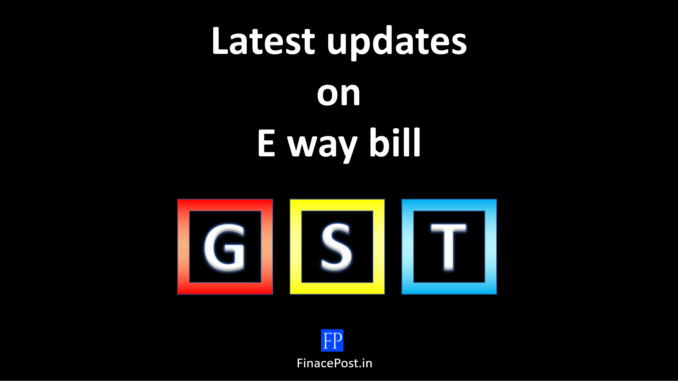
Last updated on January 22nd, 2022 at 05:00 pm
E way bill update
Latest Updates on E way Bill Portal
E way bill System has been integrated with FASTag/RFID
FASTag will enable the tracking of the movement of the vehicle carrying the consignment of goods more conveniently. Revenue Authorities will be able to trace the vehicle which is not moving in accordance with details provided in the e waybill. This is likely to stop tax evaders from circular trading and moving goods with no e waybill. (Read here the detailed analysis on integration)
Mobile Application which is being used by GST Officers to track the movement of the commercial vehicle has been upgraded to keep a watch on the real-time movement of the vehicle from toll booths. GST officers will be able to know the whereabouts of a vehicle by entering the e way bill or vehicle registration number.
Minimum one HSN code for generation of e-way bill
The E-way bill portal doesn’t allow to generate an e-way bill with only SAC codes for services. A minimum of one HSN code that belongs to the goods being transported is a mandatory requirement for the generation of e-way bills.
Though this an understood and a basic concept as e waybill is required only when goods are being transported. Services cannot be transported. Goods for providing services can be transported.
As per my understanding, mandatory quoting of a minimum of one HSN was updated so the Government could regulate the ones who supply the goods under the guise of goods sent to job work. Defaulters/ tax evaders are always looking for a loophole in the system which can be used for the wrongdoings.
Click>> Changes after Rule 138E was implemented
E-way Bill for Over Dimensional Cargo
Over Dimensional Cargo is a vehicle that carries a single indivisible unit whose dimensional limits exceed the prescribed dimensional limits under the Motor Vehicles Acts. As per rule 93 of Central Motor Vehicle Rules 1989, an over-dimensional cargo can move up to 20 KM a day.
We all would have come across vehicles that carry blades of windmills, huge machines which cannot be knocked down for transportation, etc move really slow and hence would require more time to reach the destination.
Earlier while generating e way bill there was no provision to select the over-dimensional cargo as a mode of transport which would grant the validity based on the KM limit of the vehicle as prescribed in the Motor Vehicles Act and rules made thereunder. Now for transporting goods in over-dimensional cargo, “ship” should be selected as the mode of transport providing details of Part-B of an e waybill.
Assigned Date vs Generation Date of E-way bill
Rules in and around e waybills are becoming stringent day by day and every other day social media is flooded with the news of harassment to transporters from the GST officers. In such a short span of time, we can witness so many orders passed by the Courts for e waybills. Meanwhile, the E-way bill portal is becoming user-friendly for its users.
With the new update, transporters will be able to check details of the e way bills based on the generation date as well as on any assigned date. Earlier transporters could only check the e waybills from the date of generation. This will help transporters in keeping a track of the validity of e waybills and extending the same if it is required.
How to view the list of e way bills generated on a particular date?
- Log in with your credentials on the e way bill portal ( http://ewaybill.nic.in )
- Select the tab ‘Reports’
- Select the tab ‘Consolidated EWB Generated by Me’
- Enter the ‘date’ (particular date) in the space provided
- Click on ‘Go’ for the generation of reports.
Click >> How to check/track if duplicate e-way bills were generated?
Vehicles that have temporary numbers
While generating e waybill, for the vehicles having temporary RC number will have to enter the vehicle number in a specific format starting with TMxxxxx.
Read: Inspection, detention and penal provisions of goods in transit
200 KMs per day w.e.f. 1st January 2021
The government has increased the distance to be covered by vehicles carrying the consignment of goods from 100 KMs to 200 KMs. A CGST notification no. 94 dated 22nd December 2020 was issued to change the validity period of e-waybill from 100 KMs per day to 200 KMs per day.
Related Posts
- 50th GST Council Meeting - 11/07/2023
- GST Compliance Calendar of October 2023 - 01/04/2023
- GST sections amended in Finance Act 2023 - 27/03/2023
Disclaimer: The above content is for general info purpose only and does not constitute professional advice. The author/ website will not be liable for any inaccurate / incomplete information and any reliance you place on the content is strictly at your risk.
Follow us on Social Media by clicking below
Follow @financepost_in
Be the first to comment